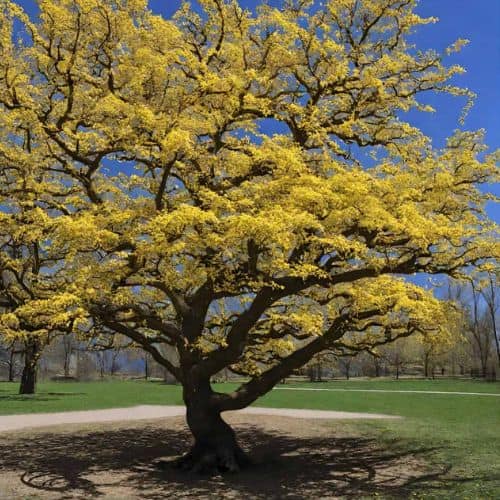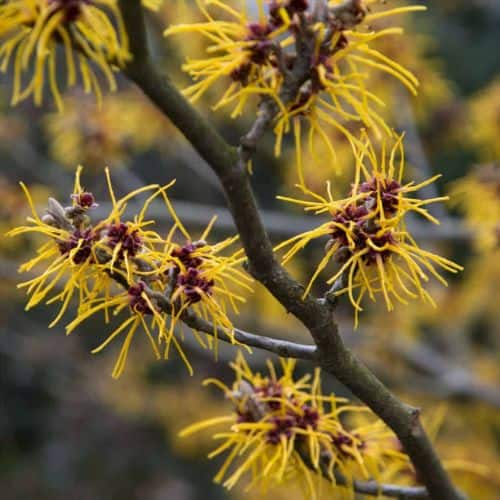The genus Hamamelis, commonly called Witch Hazel, comprises several small tree and shrub species native to North America and Asia. The name “Witch Hazel” is believed to have originated from the Old English “wice,” meaning pliant or bendable, highlighting the plant’s flexible branches. Witch Hazel is also used in traditional medicine for its therapeutic properties and as an ingredient in various skincare products.

Preferred Growing Conditions
Witch Hazel is renowned for its adaptability to various soil types and light conditions. While it thrives in well-drained, moist soils with a slightly acidic to neutral pH, it can tolerate a range of soil textures. The plant performs well in both full sun and partial shade. This adaptability makes Witch Hazel suitable for diverse environments, from woodland gardens to urban landscapes. Additionally, it is resistant to many pests and diseases, adding to its reputation as a hardy and low-maintenance.
Regular watering, especially during dry spells, is crucial for establishing Witch Hazel. Once established, the plant becomes more drought-tolerant but consistent moisture benefits optimal performance. Pruning is generally minimal for Witch Hazel and is best done after flowering to avoid cutting off potential flower buds. Occasional checks for aphids or spider mites and promptly addressing any issues can help maintain the plant’s overall health.
Size, Shape, And Growth Rate
Witch Hazel ranges in height from 10 to 20 feet, with a similar spread, creating a rounded or vase-shaped form. Its moderate growth rate allows for steady development without becoming overly invasive. The branches of Witch Hazel are distinguished by their smooth, gray bark and unique growth pattern. As the plant matures, its branches become more contorted, adding visual interest during winter when the leaves have fallen.
Leaves, Flowers, And Bark
The leaves of Witch Hazel are simple, alternate, and broadly oval, with a slightly serrated margin. Their color transitions throughout the growing season, starting as vibrant green in spring and summer and transforming into shades of yellow, orange, and red in the fall. These late-blooming flowers serve as a valuable nectar source for pollinators, including bees and butterflies, during a time when few other flowering plants are available.
One of the most remarkable features of Witch Hazel is its unusual flowering time. Unlike most plants that bloom in spring or summer, Witch Hazel’s fragrant, spidery flowers emerge in late fall to early winter, often when other plants are dormant. The flowers, which range in color from yellow to orange, appear in clusters, creating a captivating display against the backdrop of autumnal foliage or a snowy landscape.
The smooth, gray bark of Witch Hazel and its contorted and twisted branches add a visually intriguing element to the winter landscape. As Witch Hazel matures, the bark becomes more pronounced, featuring a sinuous texture that intertwines with its peculiar growth pattern. The bark encapsulates the essence of its Old English name, “wice,” meaning pliant or bendable.

Uses Of Witch Hazel
The unique flowering time of Witch Hazel, in late fall to winter, can provide a burst of color and fragrance when few other flowers are present. When the branches are bare in winter, the distinctive growth pattern becomes more pronounced, adding architectural interest to the landscape. Witch Hazel’s native habitat in woodland areas also makes it well-suited for woodland gardens. Its ability to thrive in partial shade and its understory growth habit makes it an excellent companion plant for other shade-loving species.
Witch Hazel is also renowned for its natural astringent properties, making it a popular choice for skincare. When applied topically, it tightens and tones the skin, reducing inflammation and minimizing the appearance of pores. It is often used as a gentle toner or ingredient in various skincare products. The presence of antioxidants in Witch Hazel provides anti-inflammatory benefits. It can be used to treat skin conditions such as eczema and dermatitis by soothing irritated skin, alleviating itching, and reducing redness.
Witch Hazel’s astringent and anti-inflammatory qualities also contribute to its effectiveness in promoting wound healing. It is often applied to minor cuts, bruises, and insect bites to accelerate healing and prevent infection. The soothing and anti-inflammatory properties of Witch Hazel extend to relieving discomfort associated with hemorrhoids. Witch Hazel-based products, such as wipes or ointments, are commonly recommended for alleviating symptoms. Witch Hazel’s gentle nature also makes it suitable for eye care. When diluted, it can be used as an eyewash to soothe irritated eyes and reduce puffiness.
